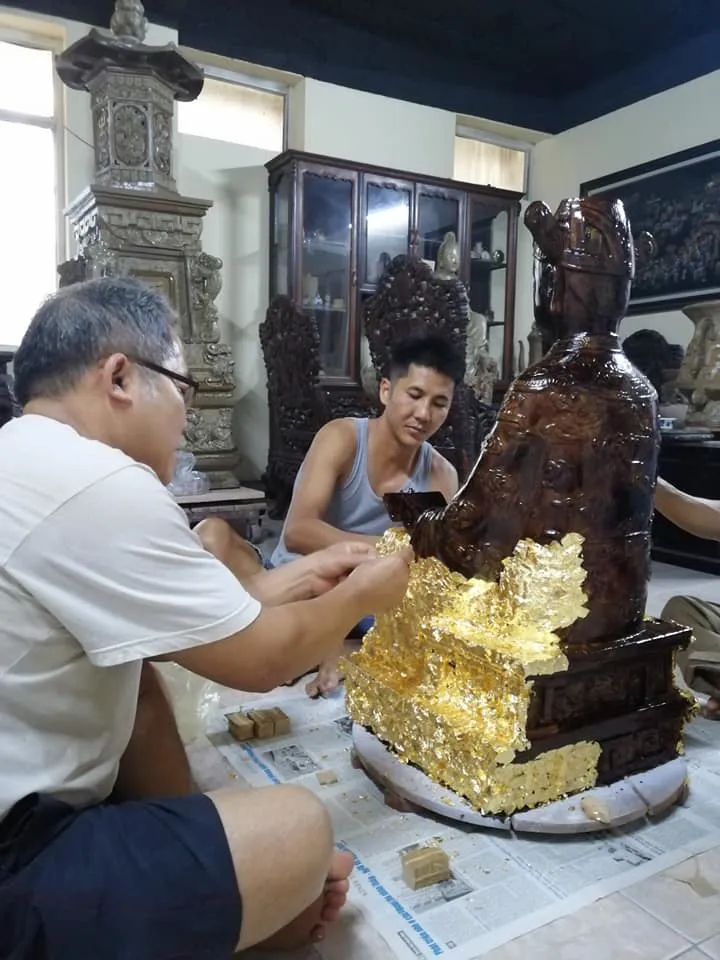Hanoi’s intangible heritages recognized national status
Among eight recently recognized intangible cultural heritages by the Ministry of Culture, Sports and Tourism, two are from Hanoi.
The gilding craft in Kieu Ky Village and rice cooking contest in Thi Cam Village, two heritages of Hanoi, have been recently added to the national list of the intangible cultural heritages by the Ministry of Culture, Sports and Tourism.
Thi Cam rice cooking contest
As a country with a wet rice cultivation civilization, rice cooking competitions are the must-have at Vietnamese village festivals, expressing their respect and gratitude to rice. One of the most animated ones is on the 8th day of the first lunar month at Thi Cam village (Xuan Phuong ward, Hanoi’s Nam Tu Liem district).
| The Rice cooking contest at Thi Cam village, Nam Tu Liem district, Hanoi. Photo: Hanoi Department of Information & Communications |
This custom aims to pray for a prosperous, happy, and peaceful new year. Legend has it that in the reign of the 18th Hung King, General Phan Tay Nhac was sent to the front to fight the enemies.
When his troops dropped off the village, he organized a cooking contest to look for cooks to serve in the army. After expelling the invaders, he returned to the village and taught the locals on farming techniques and weaving.
After his death, he was worshiped as a deity and a guardian of the village. A rice cooking contest is held every year to commemorate him.
There are four teams in the contest. Each team has 10 members who, in traditional dress, have to go to the Nhue river nearby to take water to the village. There is an award for the fastest team.
| Photo: Vietnam Plus. |
In addition, there is another award for the fastest fire-lighting in the traditional way by bamboo and straw, without using a lighter nor a match.
Moreover, they also have to get the rice ready for cooking such as husking by grinding in the mortar and screening to eliminate rice husks and grit, before washing the rice in water.
The teams only have about 30 minutes from the time the fire is made until the rice is cooked. When all four rice batches are done, they are judged by the elders in the village. The winning rice cooker features the most white soft and delicious rice.
After the winning team is announced, the rice is shared to all of the villagers. They believe that adults who eat the rice will have a year full of luck and children will grow up quickly. The contest is the pride of Thi Cam Village which has been lively organized for centuries until today.
Kieu Ky gilding craft
| There are about 50 gilding households in Kieu Ky, with about 300- 400 workers. Photo: Minh Tuan |
The craft of gilding, practiced only in Kieu Ky village (Gia Lam District, Hanoi), dated more than 300 years. The gilding process requires complex skill and a lot of patience. It requires 50 steps the make the end product.
Today, with the application of the techniques and used machines, the number of steps has been reduced to 20 phases. For example, the hammer used to pound pieces of gold and silver has been improved for the gold laminating to be faster and more efficient.
Twenty phases are a very meticulous work that cannot be replaced by any machine. With 1/10 tael of gold, the craftsmen can laminate into 980 sheets, covering a surface of nearly one sq.m. Until today, no technology can achieve this.
Before 1945, the trade thrived, supplying important materials to most of the imperial religious works such as statues of Buddha, thrones, palanquin, parallel sentences, and lacquer paintings.
| Photo: Minh Tuan |
During the war time against the French and the US, the trade almost fell into oblivion. After the wars ended, it was restored. In recent years, it has grown again, attracting workers of all ages and improving the life of villagers.
Currently, there are about 50 gilding households in Kieu Ky, with about 300- 400 workers. The end of the year is usually their busiest time. In addition to making gold leaf, they also get orders of inlaying gold in statues, worshiping and decorative items.
New products such as gold-inlaid ceramic items and wood paintings are also making the traditional craft livelier in the village nowadays.














